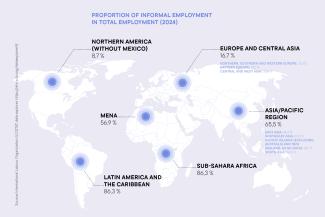Labour and employment
Facts and figures: the world of work today
 International Labour Organzation: ILOSTAT data explorer. https://rshiny.ilo.org/dataexplorer9/
International Labour Organzation: ILOSTAT data explorer. https://rshiny.ilo.org/dataexplorer9/
90 %
of the 187 member states of the International Labour Organization (ILO) have a statutory
minimum wage.*
60 %
of a sample of 160 countries adjusted the value of their minimum wages in 2022, but in only one in four countries did these changes result in a real increase in value. In the remaining countries, minimum wage increases did not compensate for inflation.*
Two thirds
out of a sample of 72 countries witnessed reductions in wage inequality since the beginning of the 21st century. The declines have been more pronounced among low-income and lower-middle-income countries. On average, low-income countries display the highest level of wage inequality and high-income countries the lowest. The sample represents about 73 % of wage employees at the global level. Informal sector workers were not included.*
57.8 %
of the world’s labour force work in the informal sector. The rate varies widely from region to region. It is particularly high in South Asia and Sub-Saharan Africa, both at around 86 %. In North America and Europe (excluding Eastern Europe), the figure is around 8.6 %.**
4.7 %
of the global labour force are international migrants. Northern America and Europe (excluding Eastern Europe) host almost half of them together.***
59 %
of 145 countries surveyed allow workers to associate with trade unions. However, only 26 % of the assessed countries effectively allow workers the right to strike.****
61 %
of the assessed 145 countries set the minimum age for full-time employment at 15 years or lower.****
35 %
of the 145 countries have no provisions for unemployment benefits. Fifty of them require severance pay on termination of employment; six have no provision for unemployment benefits or severance pay.****
53 %
of the 145 countries assessed have no legislation on parental leave. Another seven countries limit parental leave to four months.****
Sources:
* International Labour Organization, 2024:
Global Wage Report 2024-25: Is wage inequality decreasing globally?
Wage inequality has been calculated on the basis of various indicators, among them the share of workers who are low-paid and the Palma ratio, a measurement of inequality calculated by dividing the total hourly wages of the top 10 % of the wage distribution by the total hourly wages of the bottom 40 % of the wage distribution.
** International Labour Organization: ILOSTAT data explorer.
rshiny.ilo.org/dataexplorer9/
*** International Labour Organization, 2024: ILO global estimates on international migrant workers. ilo.org/publications/major-publications/ilo-global-estimates-international-migrants-labour-force
**** WageIndicator Foundation: Labour Rights Index 2024.
Labour Law for 135 Countries Covered in One Global Index -
Labour Rights Index
Isah Shafiq is a student of political science at Goethe University Frankfurt and a student assistant at D+C.
euz.editor@dandc.eu



